China is doing all it can but coronavirus outbreak may get worse before it gets better
Summary
With the end of the Spring Festival holiday on February 2, the largest annual human migration in the world will unfold and lead to another spike in the number of infections.
With the WHO declaring the novel 2019 Coronavirus (nCoV) acute respiratory disease as a global public health emergency, the virus has affected over 9,700 people leading to 213 deaths though 170 people have recovered from it (figures by the Chinese National Health Commission). The nomination of the disease as a public health emergency does not alleviate the seriousness of it, rather it signals support for the Chinese establishment in dealing with the crisis. However, with the end of the extended Spring Festival holiday on February 2, the largest annual human migration in the world will unfold and lead to another spike in the number of infections.
The incidence of the virus began in early December, supposedly in a seafood market in Wuhan (though this has not been established) when a patient exhibited pneumonia-like symptoms. In a span of two weeks, Chinese scientists had managed to isolate and identify the genetic sequence of the virus – a laudable feat. The virus is structurally similar to the one that caused the 2003 SARS (Severe Acute Respiratory Syndrome) crisis and even the common cold. Further, it has a low fatality (approximately 2 percent) rate and its infectiousness is thought to be low (with each case infecting 2.6 other people). However, these numbers are subject to change as new cases come to light and policies to restrict the spread are enforced.
The major problem with the outbreak is that it coincides with the week-long Spring Festival holiday – possibly the most important holiday in the Chinese calendar when millions of people travel back to homes and villages. At first, the Wuhan government downplayed the seriousness of the outbreak. Then came the abrupt quarantine of not only Wuhan but also two other cities, followed by a travel ban that now covers a population of six crore people across the Hubei region. The Chinese government has announced that it would build two hospitals in 10 days and is live-streaming it — supposedly has 40 million viewers. The start of the new semester in schools and universities has been postponed indefinitely. Public spaces including metros are being sprayed with disinfectant regularly. Spring Festival Holiday was extended by two more days to delay people from travelling.
However, even with the government doing all it can to signal that the situation being tackled, the fear pervading Chinese society is evident. In a press conference, the Wuhan mayor incorrectly wore his mask while the governor of Hubei province stumbled over a question about the number of masks produced in the region leading an online furore. From fake sellers of preventive masks to fake news about planes spraying disinfectant, grocery stores running out of supplies and areas of cities being under lockdown, Chinese social media is buzzing with misinformation.
Crackdown on misinformation
The Chinese government has tried to crack down on the misinformation. In the beginning of January, forty people were supposedly arrested for misinformation. However, these efforts are often murky because of the Chinese government’s record in censoring news that portrays it in a bad light. Indeed, the investigation of eight doctors in Wuhan, the censorship of videos and posts does not bode well for the government’s efforts.
Economists will tell you that asymmetric information leads to suboptimal decisions for the people who do not possess the information. In times of epidemics, this is even more true. Comparisons with the 2003 SARS crisis are rife primarily because of the deliberate limiting of information that led to the panic. It took 86 days then for the Chinese government to notify the World Health Organisation about the outbreak. It was this environment of curtailed information that led to an outpouring of citizens’ frustration – the first major political crisis since the 1989 Tiananmen riots. However, the Chinese government is better equipped than it was 17 years ago to put out information. It took only 23 days to notify the WHO about the outbreak. After the initial suppression of information, daily updates on wechat and weibo, and press conferences by various authorities, photos of various teams sent from all over the country to Wuhan, as well as photos of on-ground medical staff and volunteers present an image of a government that has stepped up.
Amidst this, there are also stories of the people whose lives have been irrevocably changed by the virus: The man who spent 20,000 yuan on his pregnant wife’s treatment only to pull her off the ventilator; the autistic child who died from neglect because his caretakers were quarantined; doctors in Wuhan who are having breakdowns from overwork and lack of resources. These stories are heart-breaking but there are too few of them in the current media landscape. For the time being though, this state of limbo is set to continue. As the Chinese government is scrambling to deal with the crisis, the internet will continue to reverberate with conspiracy theories, mired in fear and racism.
Hamsini Hariharan is the host of the States of Anarchy podcast and is currently based in Beijing.

Elon Musk forms several ‘X Holdings’ companies to fund potential Twitter buyout
3 Mins Read
Thursday’s filing dispelled some doubts, though Musk still has work to do. He and his advisers will spend the coming days vetting potential investors for the equity portion of his offer, according to people familiar with the matter









 Listen to the Article
Listen to the Article  Daily Newsletter
Daily Newsletter




